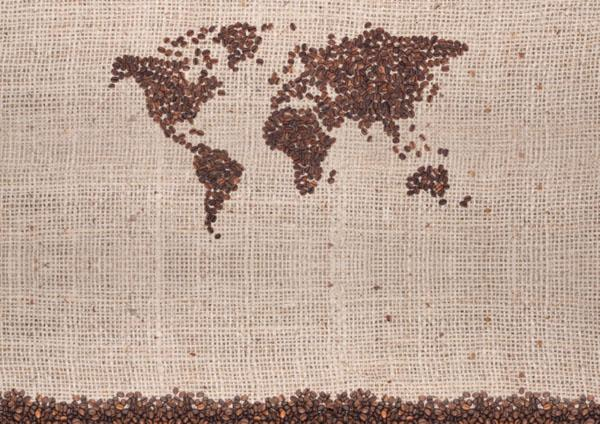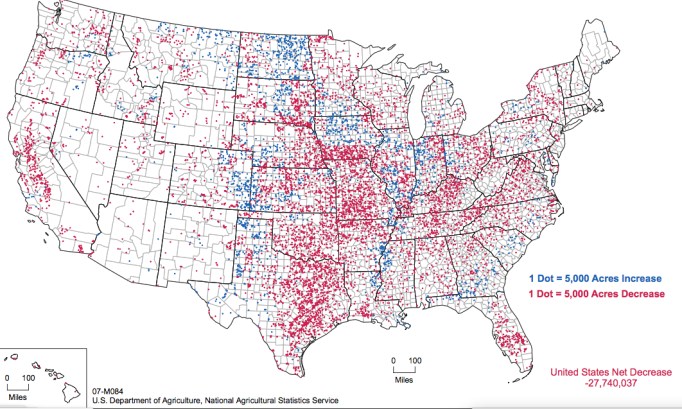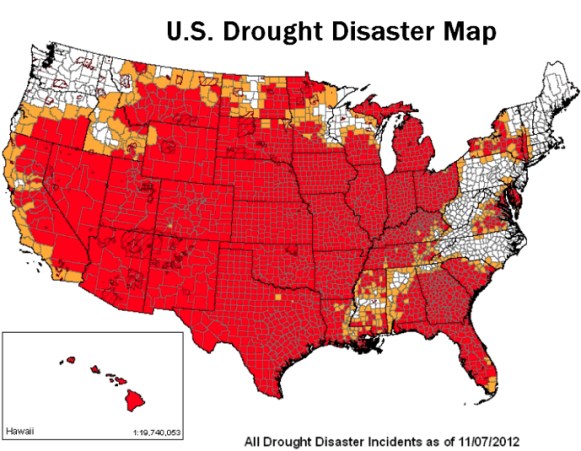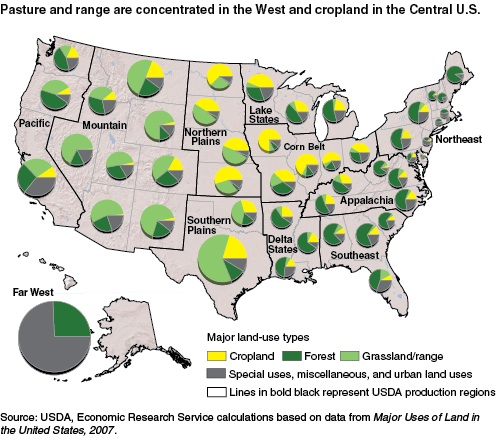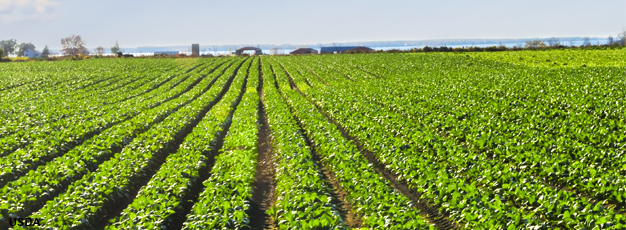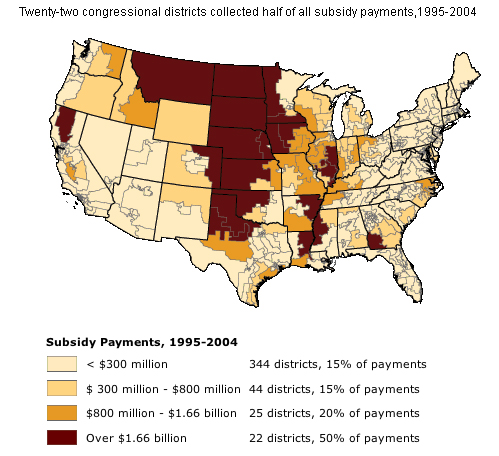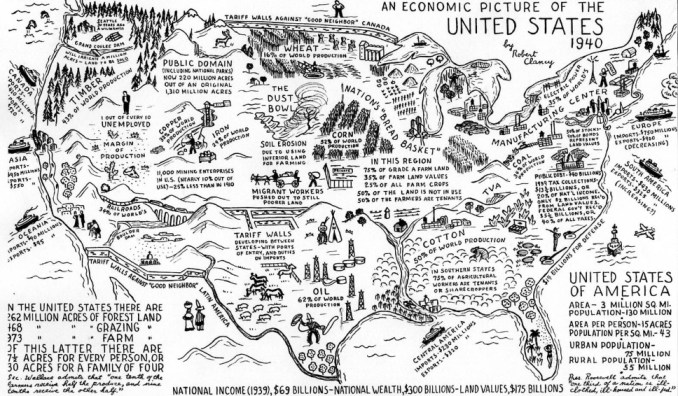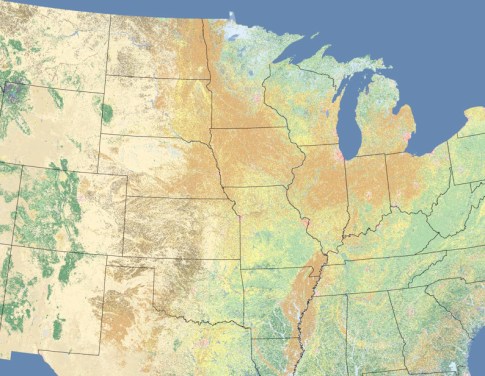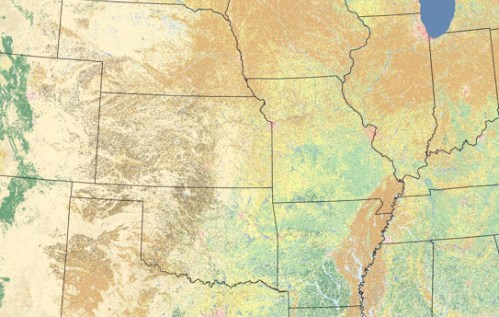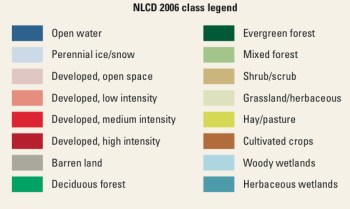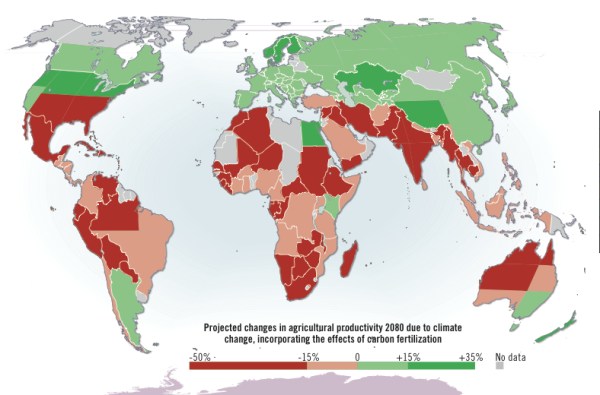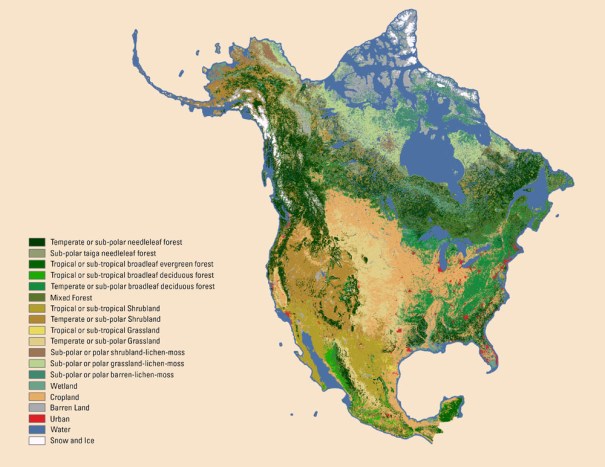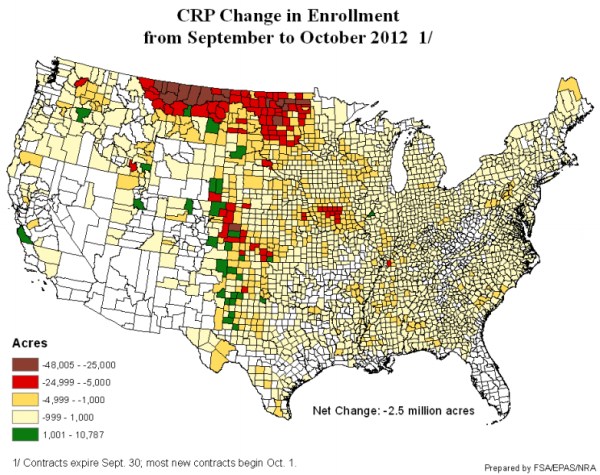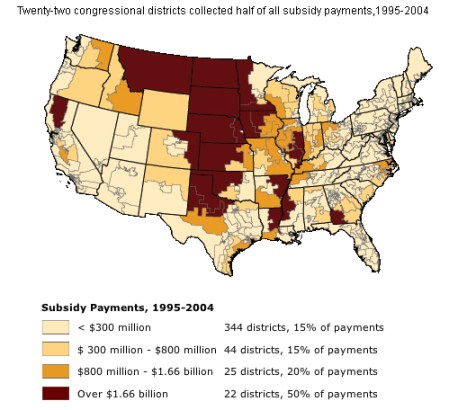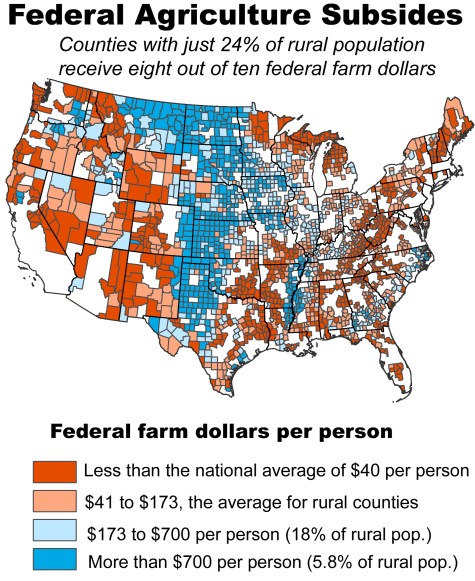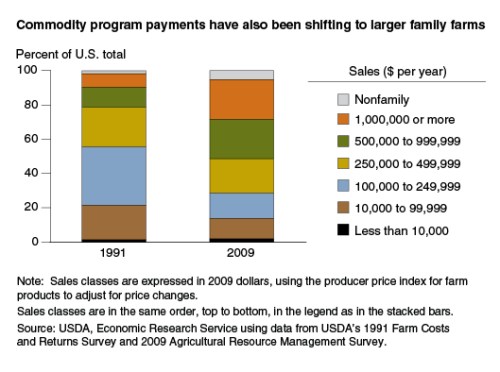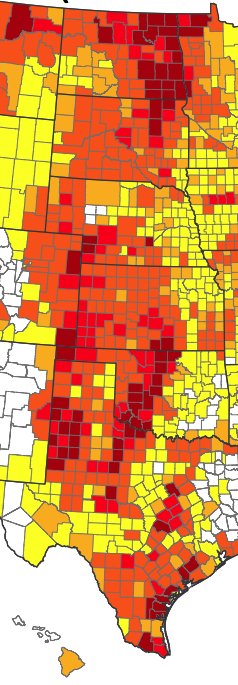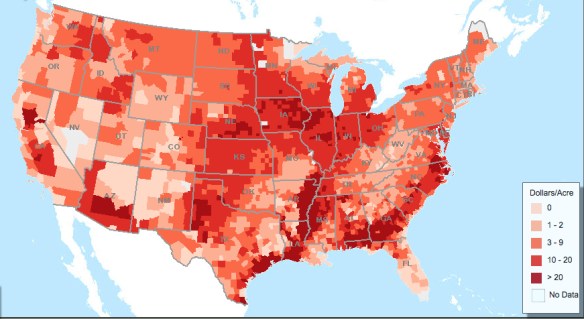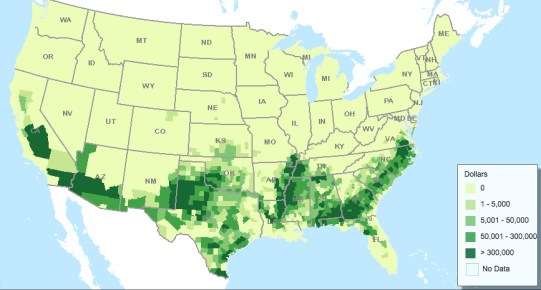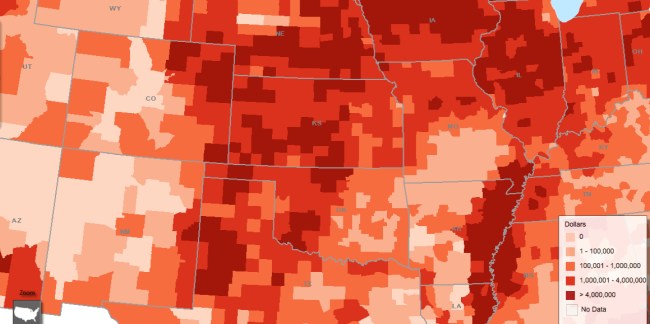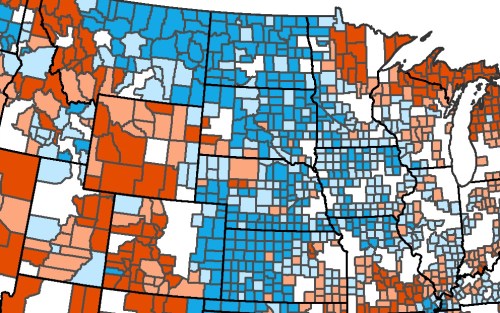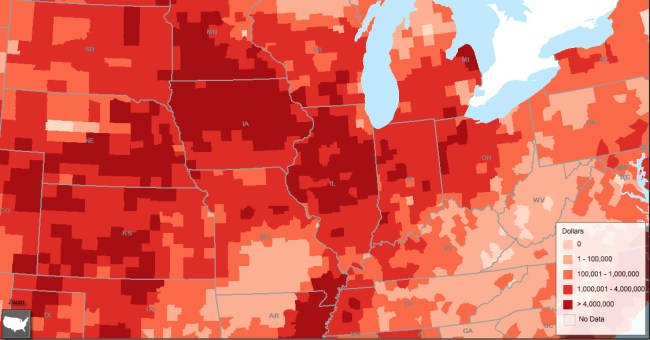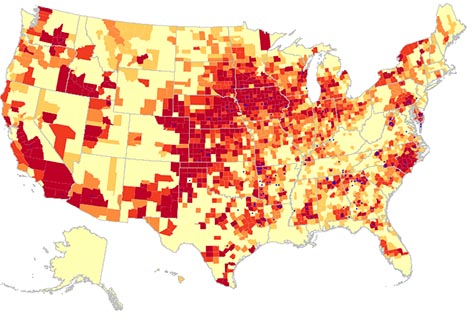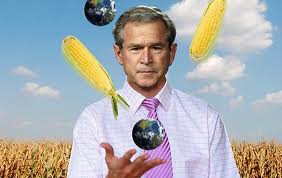Agriculture maps frame the viewer’s relation to a settled expanse and farmed space. They describe where we get our food, the intensive over-cultivation of regions of the midwest, and chart the changed fertility of cropland that have been the consequence of large-scale industrial farms in recent decades–and offer something of a basis to orient us to their configuration but to calculate their consequences.
Maps offer a palimpsest of our recent reshaping of the rural world and our relation to cultivated farmlands. As such, they bridge the remove of most Americans from an agricultural world in ways that we have, as shoppers in malls and supermarkets, largely forgotten and moreover distanced ourselves from. The distance is all too evident in our shopping habits and expectations for the year-round availability of fresh produce–even if we shop in Whole Foods. Rather than mapping farmlands’ fertility, they try to map the active recreation of the rural as a site of economic activity, as much as an ecological unit:–a recreation underwritten in our current Farm Bill, even though few seem to have familiarity with the extent to which Department of Agriculture subsidies have informed the geography of farmed lands. For although nearly 54% of the continental U.S. is devoted to agricultural land–a slightly larger amount than the 40% worldwide–almost 99% of folks in the United States don’t work on farms. The geographic and conceptual remove of these maps from rural life stands at odd ends with the fact that most policy-making decisions occur across a rural-urban divide. Indeed, the disconnect between most Americans’ lifestyle and the growing spread of large farms in rural America suggest salutary benefits in perusing the wide range of maps from open data to immerse oneself in the quandaries of sustaining rural productivity in an age of increasing food demand.
For this is how we largely use our land: world-wide, an area approximating the size of South America is dedicated crop production, and far more—7.9 to 8.9 billion acres—to raise livestock. If this division does not seem that effective, we might begin from how the devotion of our own landscape to agriculture an effective form of land-use. For this landscape provides a model for how macroeconomic interests have altered the relation to the agrarian landscape worldwide. Despite the continued romance of the pastures and crops we produce, the mapping of agriculture productivity is particularly difficult in the failure to define the multiple adversely impacts on national farms–a problem that seems multiplied by the disconnect between most politicians from our agrarian landscape, and, indeed, most concepts of space and our agricultural space–both of which have led to a disquieting hybridization of our political and agricultural space that demands to be untangled. In an age of data-driven maps, the static images of data visualizations may seem out of date. The layering of visualizations however challenges viewers to assemble an image of urban-rural relations across the lower forty-eight–by concretely mapping and rendering evident such variables as crops in farms, farms in the land, the folks in the farms and the cities–that can provide a portrait not only of where we are, but of where we’re spending money, and how we might better conceptualize the fertility of the land we farm.
If all maps give visible form to data, maps of our agrarian landscape also create data for their observers in powerful ways. Agricultural maps of land-use deserve to be examined for their inter-relations, as much as for what they ‘say.’ No single visualization should be taken as an image of the farmed landscape–but rather offer a point of entry into that the forces that shape the landscape and the very contested views of our national cropland, and what might be appreciated as the shifting ‘cropscape’ of an increasingly post-rural world. (Even if over 90% of the farms in America are small and, for a variety of reasons, family run–96% of farms with cropland are family run, producing some 87% of the total value of crop-production in 2011, according to the USDA’s Economic Research Service, based on data from the Agricultural Resource Management Survey–the landscape is increasingly defined by large agribusiness, and by how such farmers react to a market of global futures as much as national or regional needs.) The expansion of our agrarian land has been mapped by William Rankin, whose “World Cropland” (2009) provides something of a base-line for the conception of the temporal expansion and intensification of farmed crops.
 William Rankin, courtesy Edible Geography
William Rankin, courtesy Edible Geography
The layered images of farmlands that I consider in this post create a basis for future interactive analysis. Even without snazzy animations of time-lapse imaging of Google Earth or Google Earth Pro. By doing so, this post hopes to raise questions about how the relation and use of cropland to American agriculture might be most effectively mapped to would bring greater familiarity with the dilemmas of farming and agricultural practices. At a time when most are increasingly more unfamiliar with the organization of agricultural life that with the rising of the tides, we are all too ready to view agricultural practices in a purely macroeconomic–rather than environmental–lens. Although we imagine the agrarian landscape as an unconstrained or open space, the visualizations offer insight into what might be best be understood as a complex mosaic not only of individual interlocking ecological regions, as this ESRI visualization of the High Plains, Corn Belt, and Great Plains, but a complex economic dynamics it conceals. For despite its accuracy, and the differences between bioregions and eco regions, the unified landscape indeed conceals the divides created by the now dominant (if warped) view of each eco region as a source of crops on a global market–a view that has informed the rural landscapes over the past twenty to thirty years, from corn belt to the wheat fields to High Plains.
For as much as map nature, the division and conceptual of agricultural space in America is effectively under-written by the world market’s orientation to its products, rather than to the individual farm as a unit of farmed land. There has been something of a cognitive re-mapping of the national agrarian space, not only in terms of the needs of local bioregions or the diverse needs of bioregions that distinguish the alleged uniformity of agrarian expanse, that turns around the greater significance of cropland as a term of economic value, based on the extraction of grain or grasses from the land, distinct from the management of agriculture. The change in focus–and indeed of conceptual mapping–might allow us to look at the very same verdant terrain in Moscow, Idaho in markedly different ways, even before we’ve begun to map the variety of local crops.
The increased extraction of goods from crop lands–from corn to ethanol to silage to switchgrass–instills a view of the commoditized landscape, more familiar from contemporary images from real estate maps of land-value than to the locally or spatially situated sense of agricultural land in a specific landscape. The shifting nature of the farm has altered the agrarian landscape in recent times: despite some debate on the future of the family farm, the deceptive average stability of the size of farms has masked the rapid expansion of small farms that has paralleled an even greater expansion of large agribusiness. The consequent conversion of most farming acreage to cropland of far larger farms has created quite new processes of food production: if the mean size of a farm is 234 acres, most cropland is on farms of over 1,000 acres, and over a third on farms of over 2,000 acres. We have seen a very recent massive increase in the sizes of farms in the corn belt and northern plains–two areas where they have more than doubled in acreage and productivity, no doubt partly in response to agricultural technologies, fertilizer, and farm-seeding, as well as to the reclamation of grasslands.
Something of a tipping point may have arrived in the expansion of farm size in these regions of the central United States, and the power of the economic investments behind them: the ecology of the landscape threatens to become replaced by the commodities we extract and map in them. By mapping the dedicated mass of biological production across regions of the country, we can se the warping of the nature of land-use that we have perpetuated in recent years, as the practice of fresh farming has become overwhelmingly concentrated in pockets of high-scale production, whereas we abandon most land to consumption in shopping malls or residential tracts, and confine a density of large-scale farming to parts of Iowa, Illinois, and North and South Dakota, and Arkansas–and one pocket eastern Florida, California and Washington.
A similar change might under-write, in multiple senses, the reframing of the agrarian landscape of the United States as a source of investment rather than view it as a single or united landscape: provocative data visualizations of farmed land in the United States suggests that we have long ago passed a similar sense of tipping point. Data visualizations are supple tools to chart notions of cropland and pasture are less rooted in place and space, and mark the results of viewing the farms in extractable units–corn or animal feed or soybeans–that shift agrarian wealth from the fertility of the lands and bounty of a region, into a map of value and investment, and often of intensive production, fertilization, and even GMO crops.
There is something paradoxical or perverse about using data visualizations as a record of landscapes, and the end is not to aestheticize data visualizations as cognitive tools–although the visualizations offer quite provocative by their colors schemes alone: the images by which the conversion and farm management of the region has created offer interesting images to meditate on both the construction and the future of crop lands, and relative coherence of the concept as a viable construction of the agrarian space with which we live and to which we are deeply attached in ways that cannot only begin to be mapped. Such visualizations of the continuous forty-eight are a useful place to begin to visualize the transformation of cropland, because their qualitative depth presents such compelling pictures of the community and of how its inhabitants use its land. Take, for example, how Dustin Cable’s mapping of Census Data by one dot per person, on Stamen design’s base-map of the nation, affords a clear division in population just west of the Mississippi River.
1. Cropland, increasingly located in the less inhabited region between the High Plains and west of the Mississippi, has been shaped by the devaluing and reframing of cropland in terms of how much can be extracted from investment. Even in the face of new stressors on agricultural land-use, from rural out-migration to the decline of the family farm to the decline of hospitable local environments, and the government under-writing of agribusiness and large farms: crops are valued have combined to create a new agricultural landscape and concomitant foodscape that was more often linked to a macroeconomic context, in place of questions of how food can get to the marketplace. The expansion of transportation has effectively removed what food we eat from where we live for most.
By reconsidering the range of forms of mapping farms and the use of farmlands, we must consider the landscape of farming in which we increasingly live, even if our food rarely derives from it. US farming incomes have appreciably risen since 2010-11, attracting some financial markets, but the dynamics of farming are too often based on models of extraction, rather than of nurturing the local landscape. As the production of corn has increased, since 1980, 400 percent, soybeans 1,000 percent, and wheat 100 percent, as US Secretary of Agriculture Tom Vilsack has noted, largely based on agricultural technologies and machines, including GPS seed drills, combines, and tractors, the mapping of farms have relied on being under-written by tax dollars to the tune of 30-50% by government agencies that have less regard for the mapping of farmlands. If crop insurance has helped to increase productivity some 50% since 1982, the expansion of farming technologies have shifted attention from the ecosystems and landscapes: cropland used for crops declined almost uniformly by about 50% since 1982, especially in the Northern Plains, and land-use for crops by 13%–at the same time as the amount of land dedicated to pasturage markedly increased. Corn, soy, wheat, hay, cotton, sorghum and rice traditionally constitute the bulk of farmed land; corn, soy, and wheat remain the largest cultivated crops, but the production of corn has peaked.
The range of visualizations of the changing face of farming and consequences of the emerging landscape or foodscape have neither been fully calculated or understood, and, even in an age of continuous LandSat photographs of the nation’s land cover, is challenging to map. The proliferation of maps of farmlands, from Landsat images of cropland to the expanse of regional farms, suggest a compelling illusion of coverage and expanding food production that may offer a less reliable guide to an actual landscape being devoured by agricultural machinery: if our agricultural policy is intended to bolster the strength of its remaining crops, policy has changed the landscape based on macroeconomics more than on-the-ground decisions, often ignoring place and space as construction with monocrops such as corn, soybeans, or grasses that are far from demand-based. The scarcity of water for irrigation in large part need to take stock of irrigation practices in such intensively farmed lands, in the hopes to “provide a better accounting of water use, cropland productivity, and water productivity.” The consequent proliferation of satellite-based remote sensing of farmlands provide an archive and a mirror of land use that may evoke the fear of a new form of agrarian surveillance–albeit one to encourage agreed best-practices of water conservation–but rather offer a feed-back loop to survey the recent transformation of the landscape that the reframing of national farmlands has wrought.
The striking concentration of farmed acreage in the central ten to eleven states has created a quite dramatic imbalance between the demand for agricultural subsidies and desire to control wasted water that has been so sharply contested it is difficult to agree on among elected legislative representatives. Is it possible that special interest groups might gain greater sway in the manipulation of maps to chart future agricultural policy?
It is striking that during the period of just 2002-7, the acreage devoted to farmlands intensified in those central states, even as the nation saw a dramatic reduction in agriculture’s spread.
The identical period was marked by a decline in farmed cropland acreage across the entire nation that exceeded 27 million acres, a loss apparently predominantly located in the central United States, as well as California’s Central Valley and the rural South, from Louisiana to central Florida and West Virginia:
As of 2007, concentrations of those farms operated either by families or individuals were uneven in the very same regions of the central states, and in the north-central states dropped to less than 75 percent.
At the same time, national drought placed undue pressure on farms to maintain their profitability, as this map of the counties affected by drought through 2012, compiled by the USDA’s Farm Services Administration–and who are compelled to take up drought insurance–seems to make clear.
2. Maps of agricultural production reveal the increasing remove of an agricultural landscape of the nation from its cities, and from large urban areas–and indeed concentrated in a relatively restricted region of the central United States. Of the 2.3 billion acres in the United States given to agriculture, in 2007 just under one-fifth were dedicated to crops (408 million, or 18 percent)–a number that had decreased by some 34 million acres over 2002-2007. The claim to map the comprehensive changes in land-use and land-cover in the coterminous United States from 1973 to 2000–the broader goal of the professional paper–by local surveys and satellite imagery and remotely sensed data–begins to document and explain many of the deeper changes in contemporary land-cover change, to which this post returns below.
The composition of farmlands in current years suggest a marked concentration in cropland.
The notable concentration of cropland at a remove from urban markets (noted in grey sectors of wheels in the above data visualization) and at a remove from population concentrations defines something like a belt of government subsidies that sustain large regions of agriculture–often of monoculture crops–that are abstracted from actual patterns of habitation. It is impossible to map how this concentration of cropland came about from a disinterested point of view, but data visualizations offer a fragmented view of some of the narratives by which the landscape has been and is being shaped, and the distorted notions of place and space that they generate: the visualizations suggest a range of narratives about the effectiveness of agricultural subsidies, the foodscapes created in the rural United States, shaped through the changing relation of farming as an extraction of value from the landscape, rather than as a response to local economic needs. The shifting optic that stresses the relation of the landscape to the national economy has re-framed the landscape’s fertility.
Rather than providing a coherent “map” of the agricultural economy and government investment in farms, data visualizations offer snapshots that provide a sense of multiple narratives that shape the relation to the new rural landscape. The somewhat fragmented picture they offer present several narratives about how we’ve come to regard the farming of the land, and present questions of how to unite or reconcile the varied and discordant narratives we’ve come to tell about our tutelage of an agrarian landscape and how to best meet its needs. And they don’t add up to a collective image of a landscape that is designed to be habitable over the long term, let alone economically viable.
The problem of all these maps is how to visualize–and conceptualize–or relation to the collectivity of farmed lands that could best take account of their variety. Indeed, the possibility of mapping the mosaic of agricultural productivity must begin from remapping their relations to regional needs, in ways that are obscured by privileging their relation to commercial products and food markets, as opposed to food needs–or the value of locally produced food. The multiple mechanisms by which the state and government has chosen to invest in agriculture–and promote the production of certain products on farms, to the exclusion of others–have historically shifted away from traditionally microeconomic understandings of the farm and rural agriculture to more macroeconomic questions in ways that are difficult to map, but have rewritten one’s relation to the land and the obscured the landscapes that they have begun to change.
3. The remote-sensing of shifting maps of land cover in the United States is extremely of the moment, and not only for the impact of climate change. It may be odd to present data visualizations as a landscape, but as indices of both productivity and indebtedness, regional map-based visualizations offer ways of thinking about how the land is seen in ways that have not yet been fully understood. For if the mapping of rural America and its agricultural productivity are increasingly contested, the landscape . Maps of farm subsidies offer telling mirrors of the extent of government investment in agrarian expanse. They provide a sense of the expectations for the value of land-use, and frame the image of productivity one would want to produce: but they are also the result or end-product of the negotiation of local demands, by tracing an image of the changing face of farmed land riven with debts, subsidies, relative lack of profitability and indemnities, the bulk of which go to larger farms, that expand to make up for the sizable decline in farmed acres.
When we map the huge levels of out-migration that occurred from 1980 to 2000–or from the Clinton years to the Bush years–marked by a decline of the population of the so-called “corn belt” in Nebraska, Iowa, southern Michigan, and Kansas–we can see the changed character of the rural landscape in America, as much as by the huge decline in crop diversity about which I’ve blogged in relation to the expansion of agricultural production that has been fed by agricultural subsidies–monocrops that maps of food reveal as having far less reference to a region or place, at a remove from urban areas of consumption that do not best serve populations. The shifts in settlement away from the central US were clear long before 2010, but the distribution devised by Dustin Cable maps from that year’s Census maps a starkly blank central and west, into which extend feathery wisps, clinging to roads and interstates, the new rivers of rural settlement.
The long-term but recently drastic population declines from the Great Plains and Corn Belt have been a prominent back story on the remapping of American agricultural diversity, as has the declining revenues and work associated with farmlands, often worked by fewer and growing crops with greater intensity; losses of population in rural regions orient the viewer to the shifting national foodscape, whose image of dwindling population in non-metro areas reveal stressors on the economic structures of rural agriculture, and of the relation between urban and rural lands, or between the expansion of farming to meet the population growth of urban areas. (This population shift that can also be charted by the expansion of “Heat islands” of “impervious surface area,” paved urban and extra-urban areas, mapped by Landsat images and night-time lighting, that exert disproportionate influence on climate change and remove a sense of urban settlement from agricultural space.) The loss of populations to some extent mirror the decline of family farms and rise of agribusiness, which tries to meet growing population needs.
This picture gains another layer of complexity once we consider the infusion of government subsidies to agriculture in the very same states–subsidies inflating monocrop cultivation that have created a new map of the country’s farmlands, over the decade dominated by the previous Farm Bill, and created a new and unprecedented level of indemnity and indebtedness in farms that are now considered as cropland, but often face too little water to be productive. While funds were distributed, they were concentrated in the same area where economic profits declined, and family farms shuttered–and an overall decrease in cropland nationwide was offset by increasing amounts of land dedicated to pasture and grasslands, according to the 2011 USDA ERS report. There is a tortured logic of dedicating increased land to corn and silage as animal feed: since it takes 10 to 14 pounds of grain-based feed for a cow to gain 1 pound of flesh; subsidizing animal feed is an outrageously uneconomic way to produce our food supply–although the international market for American meat is high.
Many of the same farms and acreage of farmlands are enrolled in federal crop insurance, changing the complexion of farms and character of government subsidies for land and increasing fear of their indemnities–and an increasing amount of farms enrolled in insurance programs nationwide, but especially dense in areas where state farming programs are established.
4. What are the reasons for this investment, aside from the desire to keep the local economy afloat in hard times? Despite the relatively restricted regions of intensive planting of subsidized crops, we remain tied to the mindset of a picture of the nation’s economically productive landscape as it was imagined circa 1940, when one-third of the world’s production of corn came from the central states, and half of the farmers in the central United States were tenant farmers:
The current agrarian landscape has sharply diverged from one where 62% of global production of oil was located, 52% of the entire world’s corn was harvested and Grade “A” farmland existed across the Midwest. But the attempt to invest money in the landscape to bolster its production of economically desirable products that might perpetuate this image, even at the expense of local farms and rising levels of indemnity. Protectionist legislators have continued to write into and perpetuate in our most recent national Farm Bill, although that landscape no longer exists, even if it struggles to support the image of a fertile range of grazing and farm land in the “Nation’s Bread Basket” in a land where subsidies are crucial and indemnities endemic, and local ecologies often overlooked.
The more restricted areas of cropland, combined with the recent expansion of federal subsidies to certain areas, regions, and crops reflect the relative constraints of crops within the national land cover–whose row crops are measured below across the coterminous United States–can be traced from 1992 to 2006, with special attention to relations of row crops (light brown), pasturage (yellow) and shrub lands (tan) in the central states–noting the tortured logic of dedicating cropland to animal feed if it takes 10 to 14 pounds of grain-based feed for a cow to produce but 1 pound of animal flesh.
The Multi-Resolution Land Characteristics Consortium from 2001 reveals deep inroads of grasslands–with a slightly changed color-scheme–at a stunning spatial resolution of thirty meters, using remotely sensed Landsat Enhanced Thematic Mapper+, to differentiate land cover, and show an expanding northwest and midwest, even if the changes are slightly exaggerated by a stronger color spectrum–in which it almost seems that the physical remove of these row-crops from agrarian needs creates its own internal economy of production that has altered how cropland is conceived across the central states.
 USGS Land Cover Institute (LCI), 2001
USGS Land Cover Institute (LCI), 2001
The 2006 wall-to-wall land cover database, although it groups crops collectively, shows increasing inroads of pasture (yellow) and grasslands (lightest green) and slightly diminished cropland:
It might be compared to the highlighting of pasturage in a lighter almost neon green in this USDA map of cropland layers of 2009:
5. The increased incursion of grasslands, pasture, and silage into the cropland in the cover layer conceals the deeper changes in the organization of agricultural expanse–but also masks the sort of crops that are growing in each region–including the expansion of corn and soy. Given the complexity of processing these groundcover maps, a sequence of data visualizations might reveal as a radically changed landscape both of government intervention and of expanding monocrops. As a point of contrast, however, the North American Land Change Monitoring System monitored the land cover of all North America in 2005, using Moderate Resolution Imaging Spectroradiometer (MODIS) to reveal the far greater expansion of cropland to the north–an area projected for greater future productivity of crops such as wheat, due both due to lower rising temperatures and the expansion of arable land for growing wheat, canola, and barley in all Canada by 15% in a 2008 United Nations’ Environmental Program map based on predicted “increased temperatures, precipitation differences and . . . carbon
fertilization for plants,” while American productivity of crops is predicted to drop some 15%-50% on account of the impact of climate change.
The image of arable land above the 48th parallel indeed seems much more expansive, anyways, and even far more fertile with crops today–not only due to a different structure of state subsidies, but also to different agrarian practices, and a high-speed rail dedicated to transporting grain to across the country.
The relatively restricted cropland in the United States was balanced by, oddly, an expansion of land dedicated to agribusiness crops that were less dedicated or directed to the dining table, and to an increasing mountain of investment in ostensible farmlands.
There is some evidence for the bad effects of the unmitigated expansion of row-crops in the landscape of the central United States. For the area of American cropland include a conversion of a substantial amount of land–2.5 million acres–from the Conservation Retention Program to the growing of soybeans and corn in North Dakota and Montana, creating some total plantings of some 97 million acres on formerly CRP lands since 2007, largely to the benefit of large agribusinesses who employ monoculture plantings, with a huge impact on the local landscapes.
The distribution across the country partly reflected a new “map” of how agriculture gained USDA appropriations to expand the growth of crops that might not necessarily meet food demand. Although the investment in agriculture lumps subsidies, disaster relief, crop insurance premiums, and conservation programs in an area effectively costs the nation; questions of such spending are perhaps too significant to be determined by guidelines of a single Farm Bill. In this map, farms have increasingly met needs for feed, fuel, and fiber, even while using less cropland to do so–and the design for subsidization was warped through the different agribusiness and corporate interest groups that may well have led legislators to concentrate resources in specific legislative districts, with limited investigations of their long-term effectiveness. Despite a massive conversion of nearly 400,000 acres of grasslands into cropland in 2012 alone, such “sod-saving” provisions in the Farm Bill are difficult to secure; states so notorious in converting grasslands to agricultural interests–like Florida, Nebraska, or South Dakota, and Iowa–to be known as “Sodbusters” seem indebted to the promise of jobs that big ag might secure.
A similar logic seems to play out in the receiving of agricultural subsidies to encourage the development of farmlands, most often with an eye to farm futures rather than local needs.
As a result, states are not directly subsidized–or farmers, for that matter–but the Department of Agriculture allocates funds to districts, creating a new map of the economy, as much as a map responding to needs of crop-cultivation or food-needs, based on this map of subsidies collected in bulk by some twenty-two congressional districts in the decade 1995-2004.
6. Such representations reflect the realities of the shifting agrarian landscape. They offer resources to refine our picture of the land by delineating varied concentrations of national resources by government investment. These representations of agrarian landscapes serve as a gauge to negotiate our relations to reality, as much as to measure them, placing into visual relief how we project value onto agricultural landscapes without attending to the specificity of their character–and tend to link value to the continued economic productivity of rural lands in ways that deny local changes. This even extended to the conversion of much “highly erodible land” (HEL) into cropland for moneys from 2008-12, often to intensify the farming of subsidized corn and wheat, filling areas from Montana to Texas that are centered in what was once a Dust Bowl devastated by persistent drought.
This occurred even as large numbers of wetlands, also important wildlife habitats of their own, and wetland buffers, were were also being converted to cropland in many of the same regions of the Dakota prairies, Montana and Minnesota, adding up to a loss of far over 15, 300 acres each year from 2001 to 2011–most (60%) in order to plant corn and soybeans.
The individual county costs for such conversion of such acts of bad agricultural stewardship averaged, in the case of counties loosing wetlands, $10.1 million, and in counties of highly erodible lands $5.8 million–four and two and a half times the national average respectively. And particularly notable seems the expansion of conversions of either both wetlands and highly erosive lands (framed in violet), or either wetlands (framed in sky blue) or erosive lands (framed in light green) both in Montana, upstate and western New York state, Texas and in northern California, suggesting a diffusion of bad practices of land-reclamation at much cost.
7. How much does this actually cost the government? And is this level of investment and subsidization financially sustainable? If one filters data and divides subsidies per inhabitant of rural regions, the largest six programs of USDA funds pump debt to diminished rural populations at astounding rates; if farming remains less profitable, it has gained and retained legislators’ ears for continued support for subsidizing crops as corn in areas of low population–dominated by agribusiness.
Despite the typo, the map displays an astounding concentration of relative farm dollars in North Dakota, South Dakota, and Nebraska–as Kansas, the southernmost state shown in the below map of subsidized farms in local counties, and bright blue Montana in the upper left.
The limited profitability in many of the very same regions–and indeed the focus of profitability only in states of the corn belt such as Iowa–suggest the deep economic constraints about such macroeconomic policies, and the limited success of farm income in many of the same regions in 2005–even as governments have shifted their investments to larger farms–with under 30 percent of farms receiving commodity program payments in a typical years. Indeed, the shift in the allocation of funds to farms with higher incomes and higher-income households has encouraged commodity-related programs–like grain sorghum, wheat, oats, or soybeans–that are removed from real food needs, and creates a picture of radical imbalance for the smaller farm, privileging “high value crops” in a macroeconomic sense, in ways that were often removed from actual farm income in many regions outside of Iowa, Nebraska and select parts of Missouri and Texas in this map of 2005.
The shift to larger farms whose incomes actually far exceed average household income in recent decades created a new dynamic of regional and rural investment that has privileged a food trade removed from local needs or a variety of foods, and considerably increased the percentage of non-family farms in ways that seem poised to increase over future decades.
Are the results even profitable? The level of indemnity is striking. There is not only considerable variation in crop indemnity nationwide, but evident intensity in regions of greatest population loss that are relatively removed from metro centers:
The patchwork strip of heavy indemnities of over $10 million per county, designated in dark brown, that run across the center of the country in 2010 (and are particularly concentrated in North Dakota, Nebraska, Colorado, Kansas, Oklahoma, and Texas–all big foci of federal farm expenditures) raises question of the allocation of farm dollars in any Farm Bill, and indeed how to encourage local best practices with federal policies. Can such levels of indemnity be fiscally justified as a food policy?
How do they indeed distort the sort of food policy that the government might want to encourage? The question of best managing the balances of investment in the continued productivity of farmlands may have been too long framed in macroeconomic terms removed from local markets or best food practices–farm dollars being dedicated to the production of grains not destined to be consumed by human mouths, and whose cultivation imposes increasing costs for limited exchange value. Are these losses concealed in most maps of investment, and what sort of image of crop production do they effectively produce?
Some of the same states are highlighted in the below, more detailed, map of such direct and counter-cyclical payments–those payments that depend on weather changes or currency fluctuations, rather than cycles of agriculture–emerge in the recent he Farm Program Atlas, mapped for the USDA by Anne Effland, Vince Breneman, David Nulph, and Erik O’Donoghue, mapping variations in the dollars received by local farms in 2009. (The atlas will be completed through 2012, but this map provides an initial snapshot of where the money goes, county by county.) It offers a baseline of a picture of the benefits that the seven largest USDA programs give the nation’s farmers that is likely to be a touchstone in future debates.
The fluctuations charted respond to global markets and profits on crops, now removed from the calculus of local, regional, or national needs. Given that in 2009 corn and soybean prices were extraordinarily high–too high to trigger counter-cyclical payments as well as the direct–they offer an image of direct crop payments. And the image of direct cropland payments per acre is not in fact drastically different or distinct in its complexion, if it lightens the amount expended in the Northwest, Kansas, and Nebraska:
(If one were to look only at the counter-cyclical payments for that year, however, the rise in prices would make most monies appear devoted to the South for that specific year:
The different image that this provides of dollars spent in the Southland, however, is effectively a distorting mirror of the continued monies that flow to the acreage in the corn belt and across the midwest.)
If one charts the picture of the proportions of base acreage receiving either direct or counter-cyclical investment in farm dollars, a similar clustering of density emerges specific to the Midwest that suggests the remove of crops either from centers of population–metros–or areas of dense population–and even something of a marked inverse relation to population density:
The below map breaks down variations among individual counties that received dollars in ways that offer something of a mosaic not only of government investment, but a map of the competing interests that defined the future of our land use in states as of great population loss–and increased allocation of dollars/person–like Nebraska, Iowa, and Kansas, suggesting considerable local variations perhaps based on local agitation.
What this means is not only an increased investment in large agribusiness, but a skewing of investments to areas removed from urban populations in the mosaic of those areas where federal farm dollars are received, and over $700/person of farm subsidies arrive yearly.
It is the underside, as it were, of increasing “over-specialization” in agricultural production and in the agrarian landscape–and the divorce of that landscape from our changing national foodscape, whose disproportional warping over the years has been described and charted by William Rankin with visual eloquence, revealing in five colors the recent expansion of monocrops in corn (orange), wheat (green) and soybeans (red), destined for agrarian feed at considerable expense both as an investment and a use of land. Local economies, such as they exist, are sustained by agribusiness–the largest property owners in many of these states, who privilege a uniformity of crop.
8. The most dangerous implication of this mis-managed mapping of federal investment may lie in the removal of local needs from a sense of what crops are being encouraged or discouraged by the USDA, creating distorted foodscapes evident in how the below map of William Rankin clearly reveals the disproportionate amount of farm dollars dedicated to specific crops–and to practices of monoculture–that are most often removed not only from the food needs of urban areas or urban poor, but run against both good agricultural practices of local variation and environmental health.
And just to focus on the monolithic intensity of Soybean and Silage in one area, one can see how little of the per capita funds spent by the USDA on agricultural acreage actually reaches the tables of Americans, or might contribute to their dietary health.

US Government data, relatively recently released, provides a shockingly similar distribution of funds picture of roughly the same area received in subsidies, as of July 11, 2012:
9. The dramatically lopsided geographical distribution that results among farmers’ markets across the nation–those ever-present upbeat small-scale micro-economies of the food trade–is no surprise: even when providing the select with “fresher” food, such markets are removed from very centers where those subsidies arrive–the inaccessibility of those markets in the major metros to folks on SNAP programs (or food stamps that the farm bill guarantees) is no surprise because it is a sort of niche agriculture in an age of the homogenization of crops, and the withdrawal of industrial agriculture from produce:
For organic farms largely spread to areas located outside the most intensively farmed acreage in the US by 2007.
Where have the organic farms gone? Outside of the corn belt, in part, although the clearly cluster in many areas of Wisconsin, Minnesota, Montana and Iowa, but often in the Northeast, Northwest, and Central Valley of California, the great producer of nuts, fruits, and vegetables.
What happens to larger markets of food when areas of the concentration of fruits such California’s Central Valley face sudden drought? Just stay tuned. It’s most likely coming to a food-stand near you.the USDA’s Economic Research Service, using data from the Agricultural Research Management Survey
